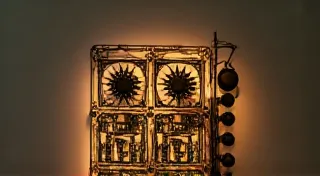Shadows of the Digital Frontier: Exploring the Potential of Low-Power Wireless Networks
There's a quiet resonance in old things. Not just the physical sound, but a feeling – a sense of connection to a time when things were built to last, meticulously crafted, and imbued with a certain soul. I think of my grandfather’s accordion, a beautiful, battered thing of bellows, reeds, and keys. It sits in my workshop, a constant reminder of ingenuity and perseverance. You can almost hear the echoes of polka music, the laughter of family gatherings, the quiet determination in his fingers as he wrestled with a challenging passage. It’s a microcosm of what fascinates me about electronics, particularly the ongoing quest for efficient and reliable communication – a modern-day pursuit, but one rooted in a similar desire: to connect, to share, and to endure.
That antique accordion, a marvel of mechanical engineering, is surprisingly relevant to the challenges we face in designing modern IoT (Internet of Things) networks. Its intricate system of air pressure and precisely engineered reeds – working in perfect harmony – highlights the importance of efficient energy transfer and synchronized operation. Just as my grandfather tirelessly maintained his accordion, tweaking and tuning it to keep it playing, we must carefully manage the power and performance of our wireless devices. The digital frontier, much like the physical one, requires ingenuity, patience, and a deep respect for the limitations of the materials at hand.

The Rise of Low-Power Wireless: Beyond the WiFi Echo
For years, WiFi and cellular networks dominated our wireless landscape. But their power consumption is significant, making them unsuitable for many IoT applications – think of remote environmental sensors, smart agriculture initiatives, or even simple home automation projects that need to operate for years on a single battery. The "always-on" nature of these networks also contributes to wasted energy. This is where low-power wireless technologies like LoRa, Zigbee, and Bluetooth Mesh step into the spotlight. They represent a shift in thinking: a move away from brute force and towards elegant efficiency.
LoRa (Long Range) stands out for its truly impressive range. It uses a spread spectrum technique that allows signals to travel kilometers in rural areas and hundreds of meters in urban environments. Imagine deploying a network of soil moisture sensors across a large farm, each transmitting data wirelessly to a central gateway. LoRa makes that a reality, drastically reducing the need for expensive and power-hungry wired connections.
Zigbee, on the other hand, is more focused on creating robust, self-healing mesh networks. Each Zigbee device can act as a router, relaying messages to other devices and ensuring that the network remains connected even if some nodes fail. This is particularly useful in large buildings or industrial settings where reliability is paramount. The layered network structure mimics the careful arrangement of valves in a complex machine, each component essential to the overall function.
Bluetooth Mesh offers a compelling option for indoor applications, providing a scalable and reliable network for connecting hundreds of devices. While its range is more limited than LoRa, it offers a familiar ecosystem and a relatively easy integration path for developers.
The Challenges of Long-Range Connectivity: A Balancing Act
While these technologies offer significant advantages, they aren’t without their challenges. Long-range wireless communication inherently involves trade-offs. Increasing range often means sacrificing data rate. The slower data speeds in LoRa, for example, mean that you can't transmit large amounts of data frequently. Similarly, achieving reliability in a mesh network requires careful planning and a thorough understanding of signal propagation characteristics.
Interference is another significant hurdle. The unlicensed frequency bands used by these technologies are often crowded with other devices, leading to potential conflicts. Designing for interference mitigation and employing techniques like frequency hopping are crucial for ensuring reliable communication.
Security is also paramount. IoT devices are increasingly targeted by cyberattacks, making it essential to implement robust security measures. Encryption, authentication, and secure over-the-air updates are all vital components of a secure IoT network.

Arduino and Raspberry Pi: The Architect’s Toolkit
Fortunately, the process of integrating these technologies into projects is becoming increasingly accessible. The Arduino and Raspberry Pi platforms have revolutionized the world of DIY electronics, providing developers with powerful and versatile tools for building custom IoT solutions. Arduino’s simplicity and low power consumption make it ideal for battery-powered devices, while Raspberry Pi’s processing power and connectivity options make it well-suited for gateway and data aggregation tasks.
Numerous readily available libraries and modules simplify the process of interfacing these platforms with LoRa, Zigbee, and Bluetooth Mesh modules. This allows even novice electronics enthusiasts to create sophisticated IoT projects with relative ease. The open-source nature of these platforms fosters a vibrant community of developers who share knowledge and contribute to the ongoing evolution of the technology.
Looking Ahead: A Future of Quiet Connections
The digital frontier is not about flashy displays and instant gratification. It’s about creating systems that work quietly and reliably in the background, collecting data, automating tasks, and improving our lives in subtle but profound ways. It's about building things that last, just like my grandfather’s accordion.
As these low-power wireless technologies mature and become even more accessible, we can expect to see a proliferation of innovative IoT applications across a wide range of industries. From precision agriculture to smart cities to remote healthcare, the potential is truly limitless. It's a quiet revolution, a shift towards a more connected and efficient world, built on the principles of ingenuity, perseverance, and a deep understanding of the delicate balance between power, range, and reliability. It’s a frontier demanding respect, precision, and a touch of the craftsman’s spirit, echoing the legacy of those who built things to endure.






